London's Victorian Garden Cemeteries
by Catherine Richards
A cemetery may not seem like the most obvious place to experience Victorian Britain, and some modern visitors might feel out of place wandering around London's 'cities of the dead'. But for those in the know, London's cemeteries have always provided a tranquil respite from the city and a fascinating insight into 19th century Britain. After being sadly neglected for many years, resulting in tombs and stones being vandalised or suffering environmental damage, cemeteries across Britain are now recognised to be valuable natural habitats as well as architecturally and historically important. For visitors wishing to get away from London's crowds, or wishing to see something a little different, or who believe the dead can tell a [his]story, here are some of the capital's best.
The Background
By the middle of the 19th century, it was clear that London was running out of space to bury its dead. The population had grown rapidly and by 1850 stood at nearly two and a half million -- more than double what it was fifty years earlier. All over Britain, churchyard cemeteries had been struggling to cope with the demands of the dead. Churchyards were full to bursting, and bodies were often buried within inches of each other. Concern regarding the spread of disease was being voiced as early as the 17th century, with many town planners and architects advocating burial outside of the city, as was practised in Ancient Rome. The first graveyard of this kind in London was opened in Bloomsbury in 1714. It wasn't until 1819, however, that the first cemetery independent of an Anglican parish church was opened: The Rosary, Norwich.
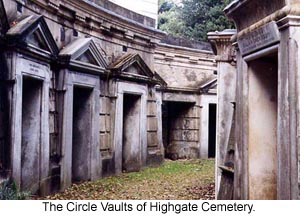 Over the next 100 years more cemeteries were built across the country, many being 'joint-stock' companies. This trend towards rural or suburban burial grounds really took off after the government became involved in the 1830s. The government was concerned that not only were more burial grounds urgently needed, but that some kind of regulation was required to avoid private companies opening burial grounds simply for profit. The cholera epidemic of 1830-31, which killed more than 52,000 in Britain, clearly emphasised the urgency.
Over the next 100 years more cemeteries were built across the country, many being 'joint-stock' companies. This trend towards rural or suburban burial grounds really took off after the government became involved in the 1830s. The government was concerned that not only were more burial grounds urgently needed, but that some kind of regulation was required to avoid private companies opening burial grounds simply for profit. The cholera epidemic of 1830-31, which killed more than 52,000 in Britain, clearly emphasised the urgency.
In 1832 a bill was passed that actively encouraged the building of more burial grounds outside the city of London. The cemeteries in this piece were all built in the nine years following the 1832 Bill: Kensal Green (1832); West Norwood (1837); Highgate (1839); Brompton (1840); and Abney Park (1840). Unlike churchyards, these cemeteries were independent of a parish church, were located outside the city in what were then suburbs, and were privately run. These cemeteries became known as the 'garden cemeteries'.
Design
The opening of Pere Lachaise cemetery in Paris in 1815 providing much-needed inspiration for the English cemetery designers, who had hitherto designed fairly functional cemeteries. With Pere Lachaise as an example, the garden cemeteries were initially informally landscaped, with sweeping roads wide enough for carriages, and smaller paths for strolling. Careful planting -- particularly of trees -- and architectural features that impressed or drew the eye were key features. The whole effect was that of a private, landscaped park, with a central chapel instead of a country house.
This fashion prevailed for the next decade. Then in 1842 one John Claudius Loudon published a book entitled 'On the Laying Out of Cemeteries'. Loudon advocated a more practical approach to cemetery layout, promoting a grid-like structure that was certainly a more efficient use of space. These ideas and his promotion of the cemetery as an educational, contemplative and dignified environment were well-received by Victorian society. Most cemeteries created from the 1850s on follow one or the other approach in their layout -- or even a combination of the two. The Victorians saw cemeteries not only as a place in which social status could be established -- in stone or marble -- but also as a place to visit, a place in which to reflect and contemplate, and a place in which to stroll -- a perfect Sunday afternoon out. This was especially true of the middle-classes.
Decline
As attitudes to death changed, however, cemeteries began to be laid out differently. Headstones became more discreet, and ostentatious tombs fell out of favour. The First World War did much to change society's attitude to death, and many of the simple, understated memorials to the victims of the Great War are testimony to this change. Add to this the practical demands of burying an ever-growing number (the population of Greater London by 1900 was estimated to be more than 5 million) and the cost of maintaining the cemeteries, and the result was that the majority of the 'garden cemeteries' started to fall into disrepair.
By the 1960s the majority were no longer financially viable. Highgate and Abney Park were virtually abandoned by the companies who owned them. Gates were locked, formerly landscaped grounds were left to their own devices, shrubs and plants engulfed and destroyed the catacombs and headstones. East London Cemetery was so overrun by the 1960s that it had become the densest woodland in London, with Abney Park not far behind.
Thankfully, there has been a renewed interest in British cemeteries, particularly over the last 20 years. Their architectural, historical, social and environmental importance is at last being acknowledged by the local councils who, in many cases, are now the owners of the sites. This shift in attitude is largely thanks to the efforts of local enthusiasts, volunteers and charities. An afternoon spent in any one of the following will give you a unique historical experience.
Highgate
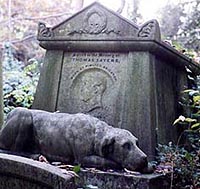 Highgate is the best known of all London's cemeteries, in part because of the bust of Karl Marx in the Eastern cemetery, but also because of the wealth of listed architectural features and notable 'residents'. The cemetery is divided into two sections. The Western Cemetery was closed down in 1975 when it ceased to be financially viable and is open only for guided tours -- which are thoroughly recommended. Of particular interest in the Western Cemetery are the Lebanon Circle Vaults (complete with a majestic 300-year old Cedar of Lebanon tree); the Egyptian Avenue, which seems to have come straight out of film set; the Terrace Catacombs; and the Julius Beer Mausoleum -- an enormous mausoleum built by businessman Beer at a cost of £5000 (the equivalent of £3 million today). Beer had never been accepted by Victorian society, having committed the cardinal sins of being foreign and having made his money commercially. With the largest mausoleum in the entire cemetery, he clearly had the last word.
Highgate is the best known of all London's cemeteries, in part because of the bust of Karl Marx in the Eastern cemetery, but also because of the wealth of listed architectural features and notable 'residents'. The cemetery is divided into two sections. The Western Cemetery was closed down in 1975 when it ceased to be financially viable and is open only for guided tours -- which are thoroughly recommended. Of particular interest in the Western Cemetery are the Lebanon Circle Vaults (complete with a majestic 300-year old Cedar of Lebanon tree); the Egyptian Avenue, which seems to have come straight out of film set; the Terrace Catacombs; and the Julius Beer Mausoleum -- an enormous mausoleum built by businessman Beer at a cost of £5000 (the equivalent of £3 million today). Beer had never been accepted by Victorian society, having committed the cardinal sins of being foreign and having made his money commercially. With the largest mausoleum in the entire cemetery, he clearly had the last word.
Notables:
Karl Marx, George Eliot, Michael Faraday, Radclyffe Hall, Carl Rosa, Sir Ralph Richardson, and a host of business founders, academics, scientists, and statesmen.
Highgate Cemetery, Swain's Lane, London N6 6PJ
Telephone 020 8340 1834
http://highgate-cemetery.org/index.asp
Kensal Green
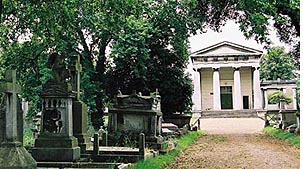 Kensal Green is an oasis of peace in an otherwise crowded, urban environment. A short bus ride from trendy Portobello and Notting Hill Gate, Kensal Green is the oldest of London's public burial grounds and has more mausoleums than any other cemetery in Britain. The cemetery has often been described as 'ramshackle', not least as the plots seem to have no discernible layout, resulting in the great and the unknown, the very old and the fairly recent, the very British and the foreign all abutting one another. In common with most garden cemeteries, much of the 75-acre site is managed as a nature reserve, with a wealth of mature trees, rare plantings and over 33 species of birds nesting there. Over 500 members of the British aristocracy are buried here, including royalty: George III's son, the Duke of Sussex (whose burial in 1843 made Kensal Green the most fashionable place to be interred); HRH Princess Sophia, daughter of George III who created a scandal by having an illegitimate child; and the Duke of Cambridge, the grandson of George III. Uniquely, Kensal Green is still managed by the General Cemetery Company, which was set up to administer the cemetery in 1830.
Kensal Green is an oasis of peace in an otherwise crowded, urban environment. A short bus ride from trendy Portobello and Notting Hill Gate, Kensal Green is the oldest of London's public burial grounds and has more mausoleums than any other cemetery in Britain. The cemetery has often been described as 'ramshackle', not least as the plots seem to have no discernible layout, resulting in the great and the unknown, the very old and the fairly recent, the very British and the foreign all abutting one another. In common with most garden cemeteries, much of the 75-acre site is managed as a nature reserve, with a wealth of mature trees, rare plantings and over 33 species of birds nesting there. Over 500 members of the British aristocracy are buried here, including royalty: George III's son, the Duke of Sussex (whose burial in 1843 made Kensal Green the most fashionable place to be interred); HRH Princess Sophia, daughter of George III who created a scandal by having an illegitimate child; and the Duke of Cambridge, the grandson of George III. Uniquely, Kensal Green is still managed by the General Cemetery Company, which was set up to administer the cemetery in 1830.
Notables:
Wilkie Collins; William Makepeace Thackeray; Anthony Trollope; Charles Babbage; Baden Powell; Isambard Kingdom Brunel; Charles Blondin; and one Dr. James Barry, who after 40 years as an eminent army surgeon turned out to be not a man at all but a woman!
Kensal Green Cemetery, Harrow Road, London W10 4RA
Telephone 020 8960 9744
http://www.kensalgreen.co.uk/
West Norwood
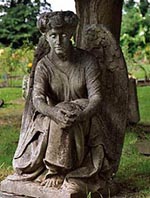 Located in south east London, in an otherwise unremarkable suburb, West Norwood Cemetery has 64 Grade II and Grade II* listed monuments. Neglect, vandalism and local government policy have all played their part over the years, and once again it is thanks to the efforts of volunteers and enthusiasts that the cemetery is better understood and appreciated today. The Greek community of London is well-represented here, with some very impressive memorials.
Located in south east London, in an otherwise unremarkable suburb, West Norwood Cemetery has 64 Grade II and Grade II* listed monuments. Neglect, vandalism and local government policy have all played their part over the years, and once again it is thanks to the efforts of volunteers and enthusiasts that the cemetery is better understood and appreciated today. The Greek community of London is well-represented here, with some very impressive memorials.
Notables:
Mrs Beeton (cookery); Sir Henry Doulton (pottery); Sir Henry Tate (as in Tate Gallery); Hiram Maxim (guns)
West Norwood Cemetery, Norwood Road, London SE27
Telephone 020 7926 7900
http://www.fownc.org/
Brompton
Brompton is managed by the Royal Parks, and as such is very well-maintained. It has none of the ramshackle look of some of the other cemeteries, which have to depend on armies of volunteers. Covering 40 acres and with a chapel based on St. Peter's in Rome, Brompton cemetery contains the graves of many notables. One of the most interesting and touching burials took place on 18 June 1892, when American Sioux Indian Chief Long Wolf was interred here. He had died at age 59 of bronchial pneumonia whilst touring Europe with Buffalo Bill's Wild West Show. In 1997, after a number of years of campaigning by a British woman and Long Wolf's descendants, the chief was finally moved to a new plot in the Wolf Creek Community Cemetery at Pine Ridge, South Dakota.
Notables:
Emmeline Pankhurst; Percy Lambert, who was the first person to cover 100 miles in an hour; and Dr John Snow, a pioneer anaesthetist and discoverer of the cause of cholera.
Brompton Cemetery, Fulham Road, London SW10 9UG
Also entrance off Old Bromtpon Road.
Telephone 020 7352 1201
http://www.royalparks.gov.uk/parks/brompton_cemetery/
Abney Park
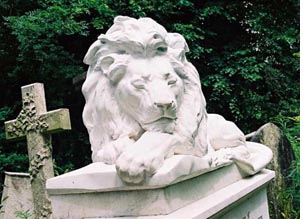 Abney Park was one of only two cemeteries in London for non-conformists -- Methodists, Baptists, Weslyans etc. -- and its sobriety is a reflection of the religious principals of those buried here. When it was first built in 1840, Stoke Newington was an area known for its religious dissidents, many of whom were founders or members of educational and social reform movements. A visit to Abney Park is highly recommended for those with an interest in religious or social history. With only one mausoleum (though hundreds of decorated stones and memorials), and a burnt-out chapel -- which has been used as a set in horror films -- the cemetery is far less showy than other London burial grounds. The tranquility can sometimes feel very atmospheric or even eerie -- an effect that the masses of planting (in its heyday it had more than 2,500 species) only adds to! After being abandoned by its owners in the 1970s, Abney Park is owned by the local council and run by the Abney Park Trust, who manage it as a nature reserve and an environmental education service. Once again, armies of volunteers are mostly responsible for the conservation and clearing of the 32-acre site.
Abney Park was one of only two cemeteries in London for non-conformists -- Methodists, Baptists, Weslyans etc. -- and its sobriety is a reflection of the religious principals of those buried here. When it was first built in 1840, Stoke Newington was an area known for its religious dissidents, many of whom were founders or members of educational and social reform movements. A visit to Abney Park is highly recommended for those with an interest in religious or social history. With only one mausoleum (though hundreds of decorated stones and memorials), and a burnt-out chapel -- which has been used as a set in horror films -- the cemetery is far less showy than other London burial grounds. The tranquility can sometimes feel very atmospheric or even eerie -- an effect that the masses of planting (in its heyday it had more than 2,500 species) only adds to! After being abandoned by its owners in the 1970s, Abney Park is owned by the local council and run by the Abney Park Trust, who manage it as a nature reserve and an environmental education service. Once again, armies of volunteers are mostly responsible for the conservation and clearing of the 32-acre site.
Notables:
William and Catherine Booth; William Bramwell Booth; Susannah and Frank Bostock (notable for their sleeping lion memorial); Emily Gosse (naturalist);
George Leybourne (otherwise known as 'Champagne Charlie.')
Abney Park Cemetery, Stoke Newington High Street, London N16 0LN
Telephone 020 7275 7557
http://www.abneypark.org
Related Articles:
- Highgate Cemetery: London's Spookiest Cemetery, by Kavitha Rao
- https://www.timetravel-britain.com/articles/london/highgate.shtml
More Information:
We regret that we no longer have the resources to maintain up-to-date links and/or hours and pricing details for the various sites and attractions listed on this website. For more information about the location(s) listed above, please use your favorite search engine or visit Wikipedia.
Catherine Richards Golini is a freelance writer, English teacher and editor. Only one of these activities currently pays the bills, though all bring satisfaction. Born in Wales, raised in Devon and with eighteen years in London, she currently lives in the south of Switzerland with her husband and daughter. She returns to London and to north Wales frequently, where she spends an unhealthy amount of time in pubs, on piers and in cemeteries.
Article © 2005 Catherine Richards; Photos © Sue Bailey
|
